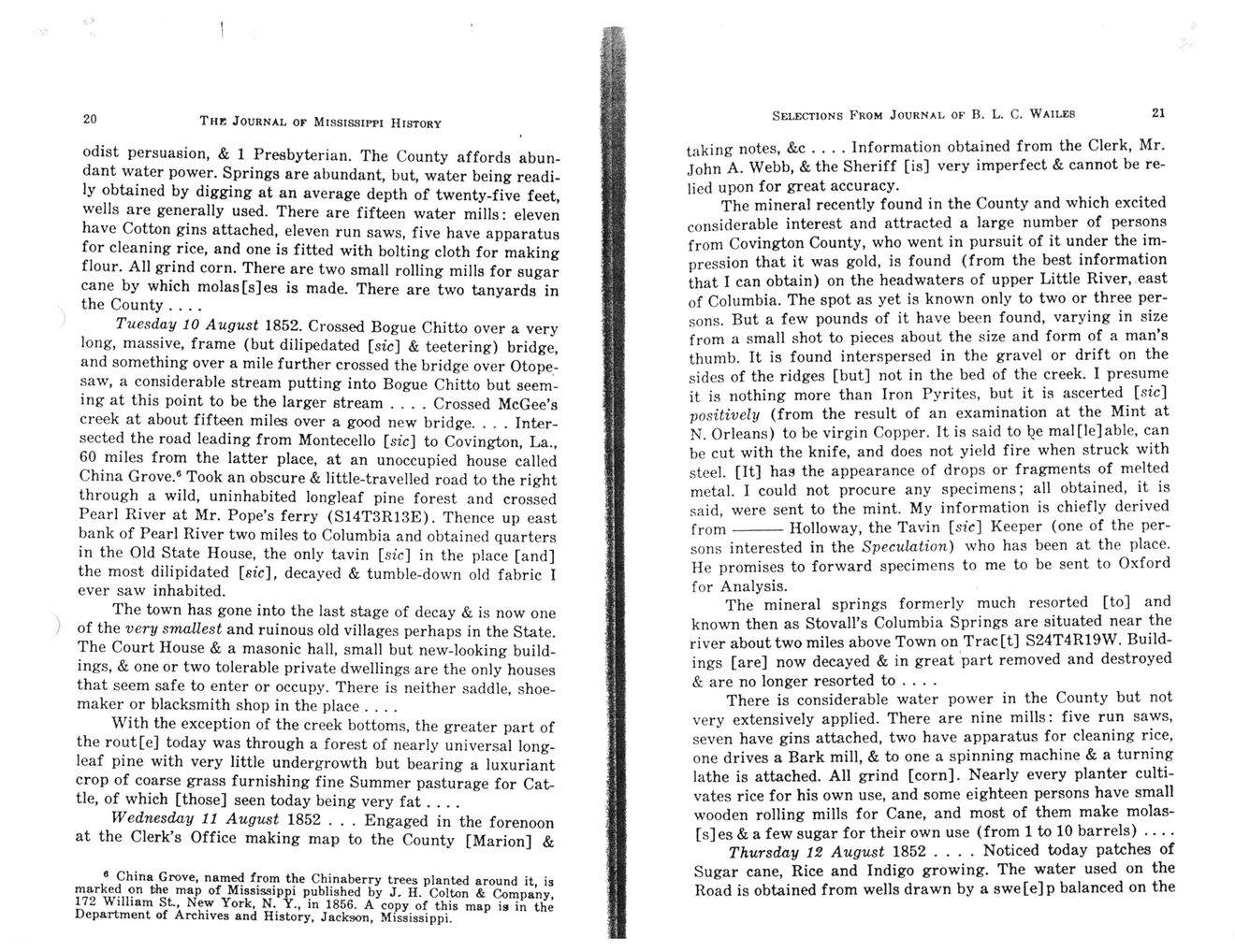This text was obtained via automated optical character recognition.
It has not been edited and may therefore contain several errors.
20 The Journal of Mississippi History odist persuasion, & 1 Presbyterian. The County affords abundant water power. Springs are abundant, but, water being readily obtained by digging at an average depth of twenty-five feet, wells are generally used. There are fifteen water mills: eleven have Cotton gins attached, eleven run saws, five have apparatus for cleaning rice, and one is fitted with bolting cloth for making flour. All grind corn. There are two small rolling mills for sugar cane by which molas[s]es is made. There are two tanyards in the County .... Tuesday 10 August 1852. Crossed Bogue Chitto over a very long, massive, frame (but dilipedated [sic] & teetering) bridge, and something over a mile further crossed the bridge over Otope-saw, a considerable stream putting into Bogue Chitto but seeming at this point to be the larger stream .... Crossed McGee’s creek at about fifteen miles over a good new bridge. . . . Intersected the road leading from Montecello [sic] to Covington, La., 60 miles from the latter place, at an unoccupied house called China Grove.6 Took an obscure & little-travelled road to the right through a wild, uninhabited longleaf pine forest and crossed Pearl River at Mr. Pope’s ferry (S14T3R13E). Thence up east bank of Pearl River two miles to Columbia and obtained quarters in the Old State House, the only tavin [sic] in the place [and] the most dilipidated [sic], decayed & tumble-dow'n old fabric I ever saw inhabited. The town has gone into the last stage of decay & is now one of the very smallest and ruinous old villages perhaps in the State. The Court House & a masonic hall, small but new-looking buildings, & one or two tolerable private dwellings are the only houses that seem safe to enter or occupy. There is neither saddle, shoemaker or blacksmith shop in the place .... With the exception of the creek bottoms, the greater part of the rout[e] today was through a forest of nearly universal longleaf pine with very little undergrowth but bearing a luxuriant crop of coarse grass furnishing fine Summer pasturage for Cattle, of which [those] seen today being very fat .... Wednesday 11 August 1852 . . . Engaged in the forenoon at the Clerk’s Office making map to the County [Marion] & 8 China Grove, named from the Chinaberry trees planted around it, is marked on the map of Mississippi published by J. H. Colton & Company, 172 William St., New York, N. Y., in 1856. A copy of this map is in the Department of Archives and History, Jackson, Mississippi. Selections From Journal of B. L. C. Waileb 21 taking notes, &c . . . . Information obtained from the Clerk, Mr. John A. Webb, & the Sheriff [is] very imperfect & cannot be relied upon for great accuracy. The mineral recently found in the County and which excited considerable interest and attracted a large number of persons from Covington County, who went in pursuit of it under the impression that it was gold, is found (from the best information that I can obtain) on the headwaters of upper Little River, east of Columbia. The spot as yet is known only to two or three persons. But a few pounds of it have been found, varying in size from a small shot to pieces about the size and form of a man’s thumb. It is found interspersed in the gravel or drift on the sides of the ridges [but] not in the bed of the creek. I presume it is nothing more than Iron Pyrites, but it is ascerted [sic] positively (from the result of an examination at the Mint at N. Orleans) to be virgin Copper. It is said to Ije mal[le]able, can be cut with the knife, and does not yield fire when struck with steel. [It] has the appearance of drops or fragments of melted metal. I could not procure any specimens; all obtained, it is said, were sent to the mint. My information is chiefly derived from--------Holloway, the Tavin [sic] Keeper (one of the per- sons interested in the Speculation) who has been at the place. He promises to forward specimens to me to be sent to Oxford for Analysis. The mineral springs formerly much resorted [to] and known then as Stovall’s Columbia Springs are situated near the river about two miles above Town on Trac[t] S24T4R19W. Buildings [are] now decayed & in great part removed and destroyed & are no longer resorted to ... . There is considerable water power in the County but not very extensively applied. There are nine mills: five run saws, seven have gins attached, two have apparatus for cleaning rice, one drives a Bark mill, & to one a spinning machine & a turning lathe is attached. All grind [corn]. Nearly every planter cultivates rice for his own use, and some eighteen persons have small wooden rolling mills for Cane, and most of them make molas-[s]es & a few sugar for their own use (from 1 to 10 barrels) .... Thursday 12 August 1852 .... Noticed today patches of Sugar cane, Rice and Indigo growing. The water used on the Road is obtained from wells drawn by a swe[e]p balanced on the

Gainesville Benjamin-Wailes-1852-2